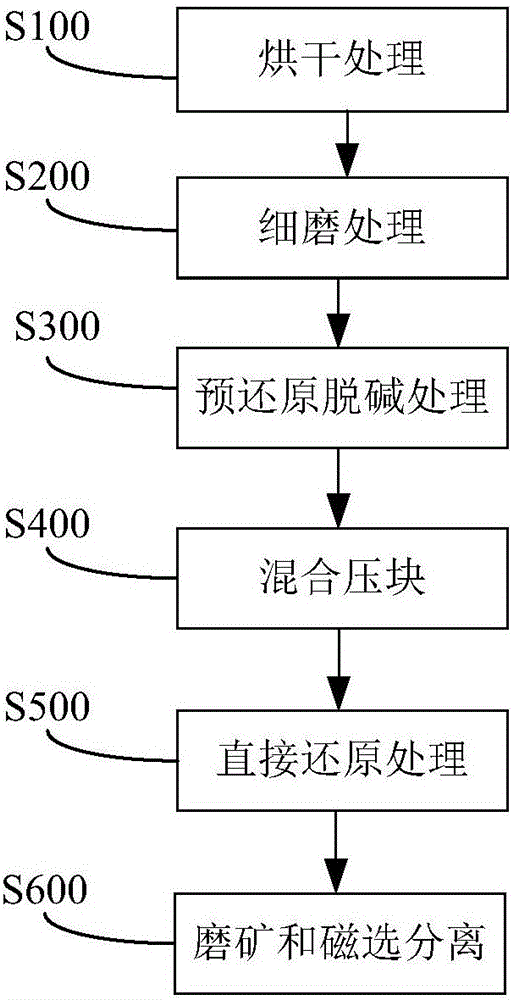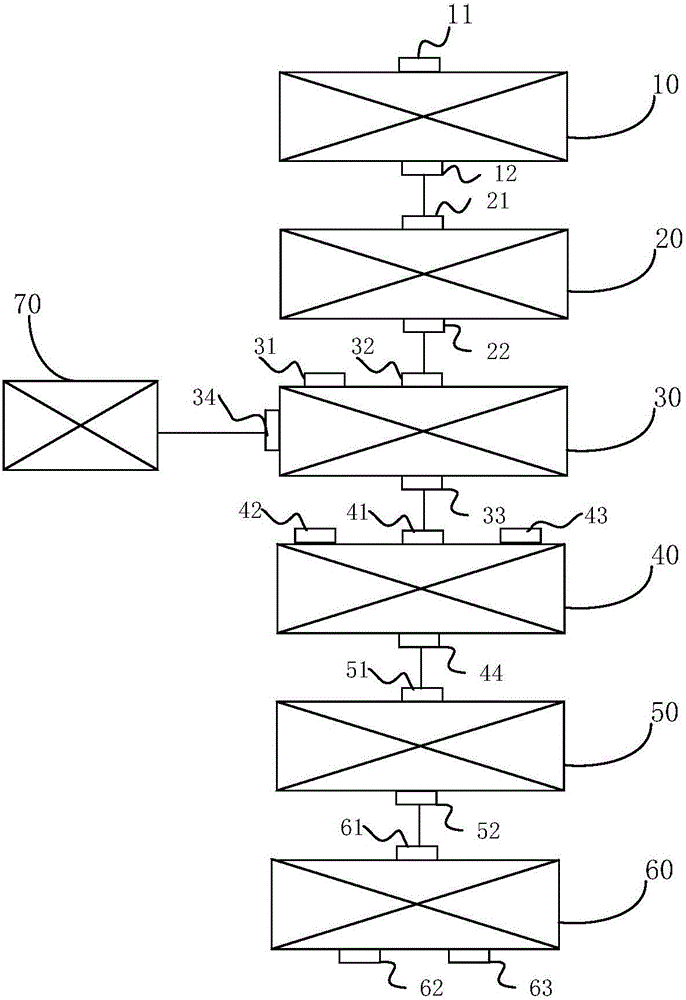Red mud treatment method and system
A technology for red mud and dealkalized red mud, applied in the fields of metallurgy and energy, can solve problems such as unfavorable separation of slag and iron, unsmooth production, serious adhesion between reflow and refractory materials, etc., and achieve important economic and social benefits, realize The effect of comprehensive recycling and accelerated reduction efficiency
- Summary
- Abstract
- Description
- Claims
- Application Information
AI Technical Summary
Problems solved by technology
Method used
Image
Examples
Embodiment 1
[0055] A certain red mud, TFe is 30.29%, Na 2 O is 5.22%. The red mud is dried and finely ground to -0.043mm, and the red mud ore powder is sent into the fluidized bed for pre-reduction dealkalization. In the fluidized bed reducing gas (H 2 +CO) was 55%, the gas temperature was 1020° C., and the reaction time was 40 minutes. The sodium content of the red mud after dealkalization is 0.39%. After dealkalization, the red mud is mixed with 18% reduced coal and 5% limestone. After mixing evenly, briquetting is carried out, and the obtained agglomerates are placed in a rotary hearth furnace for reduction. The reduction temperature in the rotary hearth furnace was 1200° C., and the reduction time was 25 minutes to obtain metallized pellets with a metallization rate of 92%. Metallized pellets are subjected to grinding and magnetic separation to obtain metal iron powder with TFe93.5%.
Embodiment 2
[0057] A certain red mud, TFe is 30.29%, Na 2 O is 5.22%. The red mud is dried and finely ground to -0.037mm, and the red mud ore powder is sent into the fluidized bed for pre-reduction dealkalization. In the fluidized bed reducing gas (H 2 +CO) was 60%, the gas temperature was 950° C., and the reaction time was 35 minutes. The sodium content of the red mud after dealkalization is 0.35%. After dealkalization, the red mud is mixed with 10% reduced coal and 5% limestone. After mixing evenly, it is pressed into blocks, and the obtained lumps are placed in a rotary hearth furnace for reduction. The reduction temperature in the rotary hearth furnace was 1250° C., and the reduction time was 25 minutes to obtain metallized pellets with a metallization rate of 93%. Metallized pellets are subjected to grinding and magnetic separation to obtain metal iron powder with TFe93.8%.
Embodiment 3
[0059] A certain red mud, TFe is 30.29%, Na 2 O is 5.22%. The red mud is dried and finely ground to -0.037mm, and the red mud ore powder is sent into the fluidized bed for pre-reduction dealkalization. In the fluidized bed reducing gas (H 2 +CO) was 60%, the gas temperature was 850° C., and the reaction time was 40 minutes. The sodium content of the red mud after dealkalization is 0.55%. After dealkalization, the red mud is mixed with 12% reduced coal and 3% limestone. After mixing evenly, it is pressed into blocks, and the obtained lumps are placed in a rotary hearth furnace for reduction. The reduction temperature in the rotary hearth furnace was 1250° C., and the reduction time was 25 minutes to obtain metallized pellets with a metallization rate of 93%. Metallized pellets are subjected to grinding and magnetic separation to obtain metal iron powder with TFe92.5%.
PUM
| Property | Measurement | Unit |
|---|---|---|
| particle size | aaaaa | aaaaa |
Abstract
Description
Claims
Application Information
 Login to View More
Login to View More - R&D
- Intellectual Property
- Life Sciences
- Materials
- Tech Scout
- Unparalleled Data Quality
- Higher Quality Content
- 60% Fewer Hallucinations
Browse by: Latest US Patents, China's latest patents, Technical Efficacy Thesaurus, Application Domain, Technology Topic, Popular Technical Reports.
© 2025 PatSnap. All rights reserved.Legal|Privacy policy|Modern Slavery Act Transparency Statement|Sitemap|About US| Contact US: help@patsnap.com



